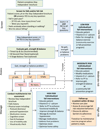Assessment and management of fall risk in primary care settings
- PMID: 25700584
- PMCID: PMC4707663
- DOI: 10.1016/j.mcna.2014.11.004
Assessment and management of fall risk in primary care settings
Abstract
Falls among older adults are neither purely accidental nor inevitable; research has shown that many falls are preventable. Primary care providers play a key role in preventing falls. However, fall risk assessment and management is performed infrequently in primary care settings. This article provides an overview of a clinically relevant, evidence-based approach to fall risk screening and management. It describes resources, including the STEADI (Stopping Elderly Accidents, Deaths, and Injuries) tool kit that can help providers integrate fall prevention into their practice.
Keywords: Accidental falls; Aged; Community health services; Preventive health services/organization and administration; Primary prevention; Risk assessment and management; Secondary prevention; Wounds and injuries.
Copyright © 2015 Elsevier Inc. All rights reserved.
Figures


References
-
- Tinetti ME, Speechley M, Ginter SF. Risk factors for falls among elderly persons living in the community. N Engl J Med. 1988;319:1701–1707. - PubMed
-
- King MB, Tinetti ME. Falls in community-dwelling older persons. J Am Geriatr Soc. 1995;43:1146–1154. - PubMed
-
- Tinetti ME, Doucette J, Claus E, et al. Risk factors for serious injury during falls by older persons in the community. J Am Geriatr Soc. 1995;43:1214–1221. - PubMed
-
- Schiller JS, Kramarow EA, Dey AN. Fall injury episodes among noninstitutionalized older adults: United States, 2001–2003. Vol. 392. Hyattsville, MD: National Center for Health Statistics Advance data from vital and health statistics; 2007. - PubMed
Publication types
MeSH terms
Grants and funding
LinkOut - more resources
Full Text Sources
Other Literature Sources
Medical

